-
Team developers should design their individual packages and classes to be
testable independently from other team members' packages.
-
Providing "canned" test data is one aspect of independently testable designs.
-
Such test data are used when data-producing packages are not yet implemented by
other team members.
- These data can also be very handy when an implemented package unexpectedly breaks, leaving users of the package stuck until the broken package is fixed.
-
Such test data are used when data-producing packages are not yet implemented by
other team members.
-
In a Java-based implementation, having individualized main methods
supports independent testing.
-
For convenience, these mains can be in model classes.
-
During the initial phases of development, it's fine to have some testing done
directly in the model classes.
-
These initial tests are designed to check that an implementation is going in
the right direction.
- The initial tests will evolve into the formal tests that are in the testing project directory.
-
These initial tests are designed to check that an implementation is going in
the right direction.
-
For convenience, these mains can be in model classes.
-
A testing main method in a model class does the following steps:
-
Construct model class(es) to be tested.
-
Construct and compose companion view(s).
-
Construct canned test data.
- Show the top-level view(s).
-
Construct model class(es) to be tested.
- Independently-testable designs allow incremental development, meaning the implementation can be tested in successively refined increments, each with more strenuous and less canned test data.
Question: How many packages and classes in the standard Java 7 library?
Answer: 209 and 4205, respectively
-
The key packages we'll cover in these notes are:
-
java.lang -- the fundamental Java language package, with classes such
as Object, String, and System.
-
java.util -- the higher-level Java language package, including the
collection classes, date/time classes, and others.
- java.io -- file input/output and related processing.
-
java.lang -- the fundamental Java language package, with classes such
as Object, String, and System.
-
The functionality provided in these packages is central to the work you're
doing in 309.
-
The classes and interfaces in these packages are summarized in the UML diagrams
that follow.
-
Package java.lang
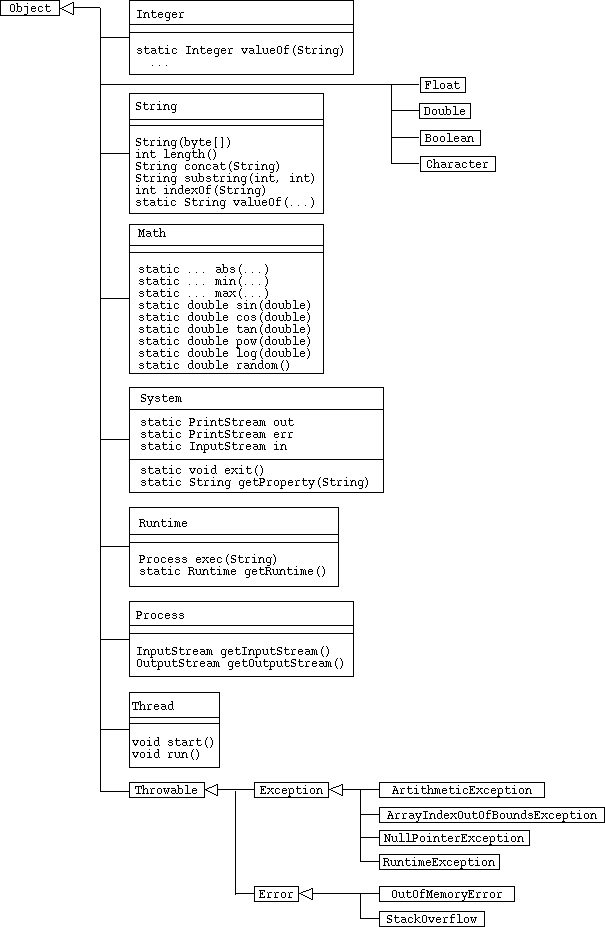
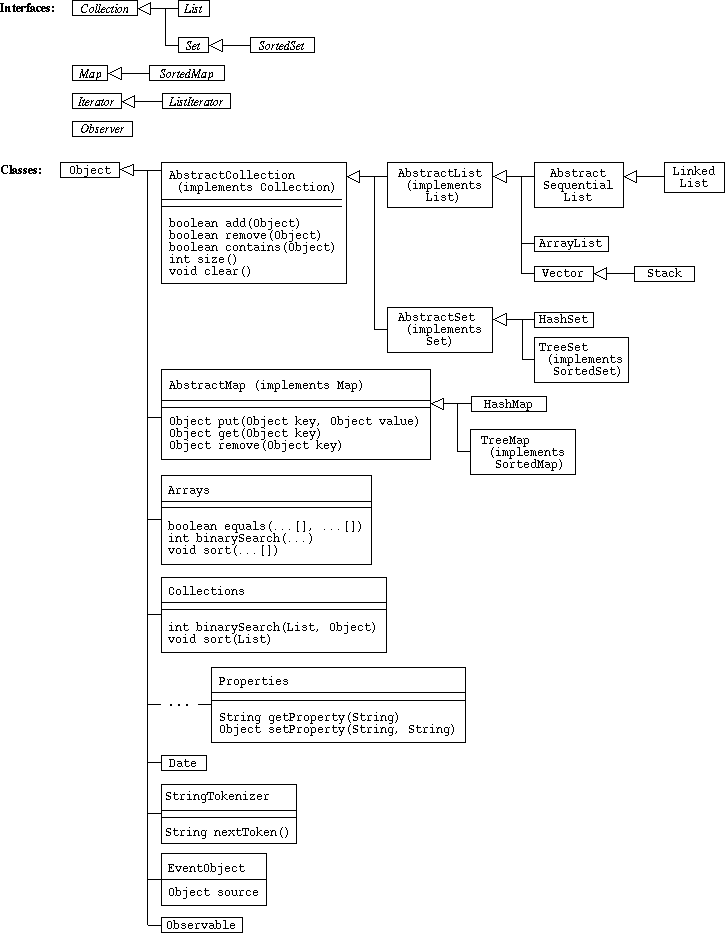
-
Package java.io
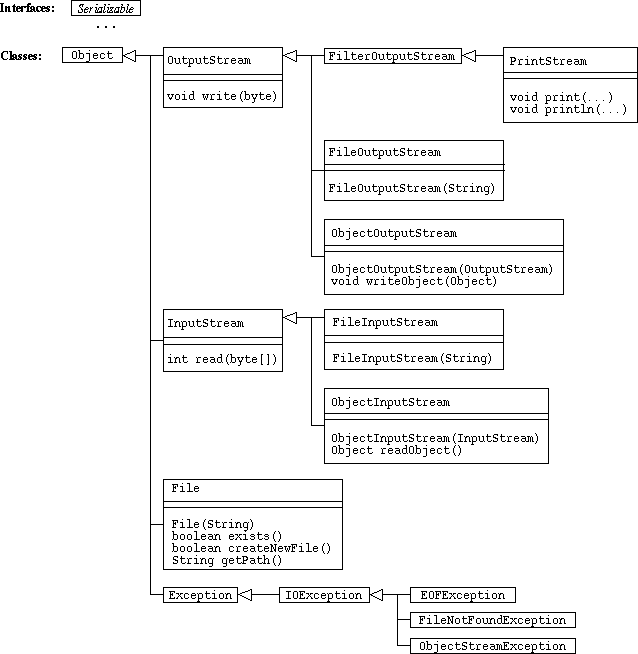
-
Useful general operations of class File include:
-
canRead
-
canWrite
-
createNewFile
-
delete
-
isDirectory
-
isFile
- mkdir
-
canRead
-
Package java.io provides very classes to read and write file data.
-
To enable a class to be written to and read from a file, the class implements
the Serializable interface.
-
Serializable has no methods, so all you need to do is implement it.
- Doing so is allows the class data to be "serialized" for sending to a file or any input/output stream.
-
Serializable has no methods, so all you need to do is implement it.
-
For output, the classes are FileOutputStream and
ObjectOutputStream
-
For input, the classes are FileInputStream and
ObjectInputStream
-
These classes are used in conjunction with serializable objects.
-
E.g., suppose we have
public class SomeModelClass implements Serializable { ... } -
To write out such a model object do the following:
model = new SomeModelClass(); /* Put some data in model ... */ FileOutputStream outFile = new FileOutputStream( "model.dat"); ObjectOutputStream outStream = new ObjectOutputStream(outFile); outStream.writeObject(model); -
To read the object back in:
FileInputStream inFile = new FileInputStream("model.dat"); ObjectInputStream inStream = new ObjectInputStream(inFile); model = (SomeModelClass) inStream.readObject();
-
To enable a class to be written to and read from a file, the class implements
the Serializable interface.
-
javax.swing.JFileChooser provides a platform-independent UI for file selection;
particularly useful methods:
-
showOpenDialog
-
showSaveDialog
-
getSelectedFile
- setSelectedFile
-
showOpenDialog
-
For initial testing of a model/view design, it is very useful to have sample
model data, that are displayed in corresponding views.
-
In the beginning, these data can be entirely "canned", i.e., defined as
constants in the model classes.
- A good place to get concrete example data values is from the requirements.
-
In the beginning, these data can be entirely "canned", i.e., defined as
constants in the model classes.
-
The model data can be delivered to the view using the same methods that will
ultimately produce the real data.
-
For example, if an iterator method is used to access model data, the body of
the method can produce the canned data.
- If collection-valued data are returned by the model, canned data can be generated by temporary testing methods
-
For example, if an iterator method is used to access model data, the body of
the method can produce the canned data.
-
Examples of the preceding two forms of canned data generation are illustrated
in the Calendar Tool code from the Week 3 notes.
-
The iterator methods in the MonthlyAgenda model class deliver a fixed
month of data to the MonthlyAgendaDisplay view class.
- In the Lists model class, there is a generateSampleList() method that generates a sample data value that appears in the requirements; this piece of data is returned by Lists.viewAppointmentList() to the AppointmentsListDisplay view class.
-
The iterator methods in the MonthlyAgenda model class deliver a fixed
month of data to the MonthlyAgendaDisplay view class.
-
When the user enters data in a GUI, a View class collects it in raw form.
-
For example, the getText method extracts the string data from a
JTextField.
-
Once raw data are collected they are:
-
Converted by the model, from their raw view form into whatever form the model
needs, e.g., a string-to-numeric conversion.
-
Validated by the model, based on preconditions to a model processing method.
- Processed by the model as appropriate.
-
Converted by the model, from their raw view form into whatever form the model
needs, e.g., a string-to-numeric conversion.
-
There are a number of ways to perform input data validation in a model/view
design.
-
In general, most if not all of the validation should be done by the model.
-
In jargon terms, we have a "smart model and stupid view".
-
What this means is that the view does not know anything "smart" about the data,
in terms of its structure, or whether it's semantically valid.
-
The view is in charge of displaying data in the UI, and managing the event-
based interactions with the user.
- The model is in charge of storing the data, and managing all of the content- based access and manipulation of the data, including validation.
-
In jargon terms, we have a "smart model and stupid view".
-
In a design that includes formally-specified of methods, a useful way to handle
data validation is with exception handling
- This style of design is discussed in the next several points of the notes.
-
Normally, when a method is entered via a call, it exits by returning to the
caller.
-
In a language with an exception handling mechanism, there is an "abnormal" way
for a method to exit -- by throwing (a.k.a., raising) an exception.
-
Raising an exception allows a method to exit in a manner separate from its
normal return-to-caller mode.
-
When an exception is thrown in a method, control does not return directly to
the caller, but rather some other active method that catches (a.k.a., handles)
the exception.
-
The catch can be in the immediate caller, but it is not limited to be.
- The catch does have to be performed by a currently active method; i.e., a method that directly or indirectly called the method in which the exception occurred.
-
Raising an exception allows a method to exit in a manner separate from its
normal return-to-caller mode.
-
Different programming languages provide different styles of exception handling,
and details differ widely between languages.
-
At the design level, we use an abstract graphical notation to depict exception
handling.
- At the implementation, we will use standard Java notation for exception handling.
-
At the design level, we use an abstract graphical notation to depict exception
handling.
-
In our high-level function diagram notation, exception handling is shown with
labeled arrows leading into and out from a method.
-
Figure 1 is an excerpt from the 309 handout on the
graphical modeling notation
which illustrates the exception diagramming format.
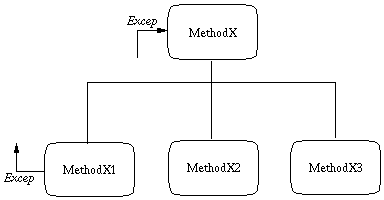
Figure 1: Event diagramming notation.
-
In the Figure, MethodX calls three submethods X1,
X2, and X3.
-
MethodX2 and MethodX2 return in the normal way.
- MethodX1 can return in the normal way, but also throw an exception that is caught by MethodX.
-
In the Figure, MethodX calls three submethods X1,
X2, and X3.
- This notation is used in the example diagrams that follow.
-
Figure 2 illustrates the use of exception handling to validate user input data,
in a Calendar Tool ScheduleEvent dialog.
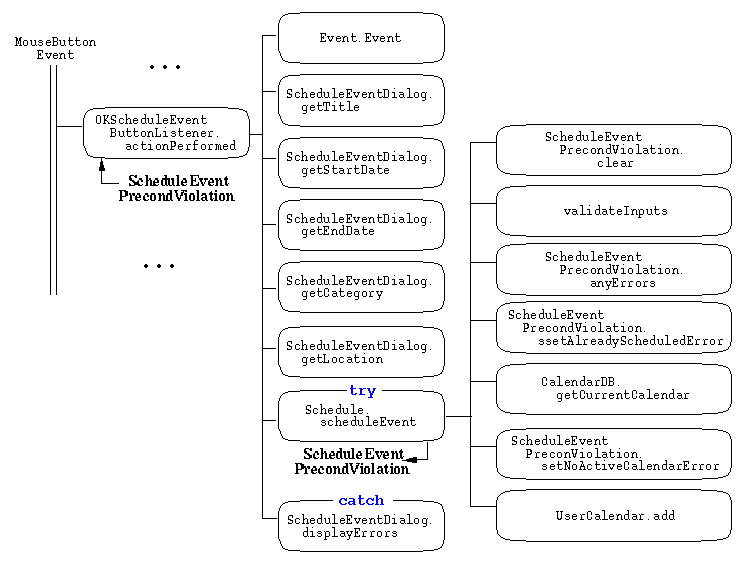
Figure 2: User input data collection and validation for scheduling an event.
-
The figure shows the model method Schedule.scheduleEvent throwing an
ScheduleEventPrecondViolation exception to the companion view method
OKScheduleEventButtonListener.actionPerformed.
-
The exception is thrown when one or more input errors is detected, based on the
processing done the the scheduleEvent method.
-
What follows is the code for
OKScheduleEventButtonListener.actionPerformed() and friends,
corresponding to the design shown in Figure 2.
public class OKScheduleEventButtonListener implements ActionListener { /** * Construct this with the given Schedule model and parent dialog view. * Access to the model is for calling its scheduleEvent method. Access to * the parent view is for gathering data to be sent to scheduleEvent. */ public OKScheduleEventButtonListener(Schedule schedule, ScheduleEventDialog dialog) { this.schedule = schedule; this.dialog = dialog; } /** * Respond to a press of the OK button by calling ScheduleEvent with a new * Event. The Event data are gathered from the JTextFields and JComboBox * in the parent dialog. */ public void actionPerformed(ActionEvent e) { try { schedule.scheduleEvent( new caltool.schedule.Event( dialog.getTitle(), // Title as a string dialog.getStartDate(), // Start date as a Date dialog.getEndDate(), // Start date as a Date dialog.getCategory(), // Category as a Category dialog.getLocation() // Location as a string ) ); } catch (ScheduleEventPrecondViolation errors) { dialog.displayErrors(errors); } } /** The companion model */ protected Schedule schedule; /** The parent view */ protected ScheduleEventDialog dialog; }
-
Here is the code for companion model method that potentially throws the
exception.
public class Schedule extends Model { ... /** * ScheduleEvent adds the given Event to the given CalendarDB, if an event * of the same start date and title is not already scheduled. * * pre: Details in next week's notes * * post: Details in next week's notes */ public void scheduleEvent(Event event) throws ScheduleEventPrecondViolation { /* * Clear out the error fields in precond violation exception object. */ scheduleEventPrecondViolation.clear(); /* * Throw a precond violation if the validly check fails on the start or * end date. */ if (validateInputs(event).anyErrors()) { throw scheduleEventPrecondViolation; } /* * Throw a precond violation if an event of the same start date and * title is already scheduled. */ if (alreadyScheduled(event)) { scheduleEventPrecondViolation.setAlreadyScheduledError(); throw scheduleEventPrecondViolation; } /* * Throw a precond violation if there is no currently active calendar. * Note that this condition will not be violated when interacting * through the view, since the 'Schedule Event' menu item is disabled * whenever the there is no active calendar. */ if (calDB.getCurrentCalendar() == null) { scheduleEventPrecondViolation.setNoActiveCalendarError(); throw scheduleEventPrecondViolation; } /* * If preconditions are met, add the given event to the currently * active calendar. */ calDB.getCurrentCalendar().add(event); } } -
Here is the code for the ScheduleEventPrecondViolation
package caltool.schedule; import caltool.PrecondViolation; import java.util.*; /**** * * Class ScheduleEventPrecondViolation defines and exception containing error * conditions for the Schedule.scheduleEvent method. It contains a list of * the specific error messages that may be output in response to a precondition * having been violated by a call th scheduleEvent. * */ public class ScheduleEventPrecondViolation extends Exception implements PrecondViolation { /** * Construct this by initializing the error message list to an empty list, * initializing the numErrors count to 0, and initializing local copies of * the error message text for each of the possible errors from * Schedule.scheduleEvent. */ public ScheduleEventPrecondViolation() { errors = new ArrayList(); alreadyScheduledMessage = new String( "An event of the given start date and title is already scheduled."); invalidStartDateMessage = new String( "Invalid start date."); invalidEndDateMessage = new String( "Invalid end date."); noActiveCalendarMessage = new String( "There is no active calendar in the Calendar Tool workspace."); numErrors = 0; } /*-* * Implemented interface methods. */ /** * Return the error list. */ public String[] getErrors() { return (String[]) errors.toArray(new String[1]); } /** * Clear all error messages. */ public void clear() { errors = new ArrayList(); numErrors = 0; } /** * Return true if any errors have been set. */ public boolean anyErrors() { return (numErrors > 0); } /** * Return the number of errors. */ public int numberOfErrors() { return numErrors; } /*-* * Error-setting methods */ /** * Set the already scheduled error message. */ public void setAlreadyScheduledError() { errors.add(alreadyScheduledMessage); numErrors++; } /** * Set the invalid start date error message. */ public void setInvalidStartDateError() { errors.add(invalidStartDateMessage); numErrors++; } /** * Set the invalid end date error message. */ public void setInvalidEndDateError() { errors.add(invalidEndDateMessage); numErrors++; } /** * Set the no active calendar error message. */ public void setNoActiveCalendarError() { errors.add(noActiveCalendarMessage); numErrors++; } /*-* * Data fields */ /** List of current error messages */ protected ArrayList errors; /** Error message count */ protected int numErrors; /** Error message for event of same date,title already scheduled */ protected String alreadyScheduledMessage; /** Error message for invalid start date */ protected String invalidStartDateMessage; /** Error message for invalid end date */ protected String invalidEndDateMessage; /** Error message for no currently active calendar in the workspace */ protected String noActiveCalendarMessage; }
-
Finally, here is the code for the general interface that all precondition
violation exceptions must implement:
package caltool; /**** * * Interface PrecondViolation defines the methods that all precondition * violation exceptions must implement. * */ public interface PrecondViolation { /** * Return the concrete error list for precondition violation. Each * position in the list corresponds to violation of a particular * precondition clause. */ public String[] getErrors(); /** * Clear out all of the error messages in this. */ public void clear(); /** * Return true if one or more error messages has been set. */ public boolean anyErrors(); /** * Return the number of error messages. */ public int numberOfErrors(); }
-
Consider the Calendar Tool view for an individual scheduled item versus a
monthly view of items.
-
In the case of a single item view, the display shows data that are persistently
stored within the model data.
- In the case of a monthly view, some of the data are persistently stored, but the other parts of the data, in particular the month/day layout, are dynamically computed.
-
In the case of a single item view, the display shows data that are persistently
stored within the model data.
- These are examples of a data persistence design pattern we'll discuss further in upcoming lectures.
-
Useful when multiple views change, based on changing model,
e.g.,
-
CalTool: daily, weekly, monthly views
- Testtool: question dialogs, question DB, tests
-
CalTool: daily, weekly, monthly views
-
In Java, this pattern is defined with the
Observable
class and the
Observer
interface, which are summarized as follows:
interface Observer { public void update( Observable o, Object arg) }class Observable { void addObserver(Observer o) void setChanged() boolean hasChanged() void notifyObservers() void notifyObservers(Object arg) } -
At the top level of the design, the MVP View class implements
Observer and the MVP Model class extends Observable:
public class View implements Observer { . . . } public class Model extends Observable implements Serializable { . . . } -
Here's an example of typical use in the Calendar Tool, where a
MonthlyAgenda view observes a UserCalendar, so that the
agenda display will be automatically updates whenever the calendar changes.
public class UserCalendar extends Model { . . . public void add(ScheduledItem item) { . . . items.add(item); setChanged(); } } . . . public class OKScheduleEVentButtonListener implements ActionListener { public void actionPerformed() { try { schedule.scheduleEvent( new caltool.schedule.Event( ... ) ); } . . . schedule.notifyObservers(); . . . } } . . . public class MonthlyAgenda extends View { public MonthlyAgenda(caltool.view.View view, UserCalendar userCalendar) { . . . userCalendar.addObserver(this) } public void update(Observable o, Object arg) { /* Get items for this month from MonthylyAgenda model and update display */ } } -
The key aspects of this example are the following:
-
Observable classes extend java.util.Observable. This extension can be
direct, or in the example above, indirect via mvp.Model.
-
Observer classes implement java.util.Observer. This implementation can
be direct, or in the example above, indirect via mvp.View.
-
The constructor of an observer class calls addObserver on all the model
classes it wants to observe.
-
In observable model classes, all mutating methods call
Observable.setChanged when they perform a mutation.
-
A mutating method is any that changes the state of the data in
its class.
-
In the above example, it's the UserCalendar.add method, which adds an
item to a calendar.
- Examples of other mutating methods are those that delete or modify items from the calendar, i.e., UserCalender.delete and UserCalender.change.
-
A mutating method is any that changes the state of the data in
its class.
-
In companion view classes, the actionPerformed method that calls a
mutating model method subsequently calls Observable.notifyObservers, when
the mutating methods succeeds.
-
This separation of calls to setChanged and notifyObservers enforces
a clean separation of model/view duties.
-
The model calls setChanged in all of its mutating methods, but not
notifyObservers.
-
The view calls notifyObservers after a successful call to a mutating
model method.
-
By not calling notifyObservers, the model maintains its independence from
its views, and other classes that are observing it.
- By not calling setChanged, the view maintains its independence from the model classes that know when and when not to signify changes in the state of model data.
-
This separation of calls to setChanged and notifyObservers enforces
a clean separation of model/view duties.
- In observing view classes, the Observable.update method is invoked via notifyObservers; when invoked, update calls appropriate model methods to query the model state and access model data.
-
Observable classes extend java.util.Observable. This extension can be
direct, or in the example above, indirect via mvp.Model.